The Apple iPhone 6s and iPhone 6s Plus Review
by Ryan Smith & Joshua Ho on November 2, 2015 8:00 AM EST- Posted in
- Smartphones
- Apple
- Mobile
- SoCs
- iPhone 6s
- iPhone 6s Plus
Dual Sourcing A9: Two for the Price of Two
Perhaps more remarkable than the fact that the A9 is built using a FinFET process however is who it is being built by. For the first time Apple is dual sourcing the SoC – rather than using TSMC or Samsung exclusively, they are using both.
Broadly speaking, dual sourcing is a practice that has fallen out of style as the number of contract semiconductor manufacturers has dwindled and the cost of chip production has gone up. Because each manufacturer has its own rules and own best practices, to dual source a chip involves designing it twice, once for each manufacturer. This has made the cost of dual sourcing increase over time, and consequently dual sourcing falling out of fashion.
This of course is a big part of what makes Apple’s decision to dual source so unexpected. Apple is taking a much bigger gamble this time around by dual sourcing than they have on past SoCs where it was produced by a single manufacturer (be it TSMC or Samsung). Dual sourcing means that Apple’s costs to tape-out and bring-up A9 have very nearly doubled; they have to tape-out each version of the A9 for the respective fab’s rulesets, and then they have to go through the bring-up process with each in order to dial-in the yields and clockspeeds. They at least get to reuse the underlying architecture (e.g. Twister CPU and their PowerVR GPU), but actually creating a chip design for each fab is a significant part of the development costs for A9.
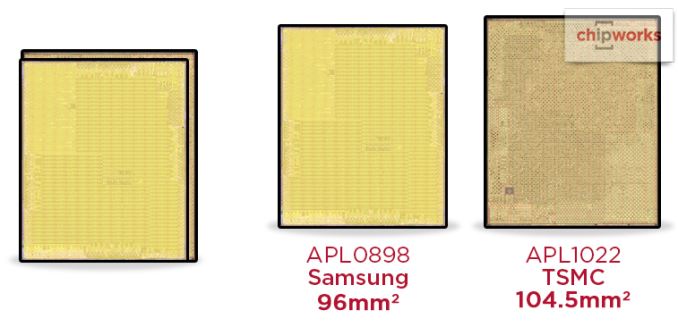
Samsung vs. TSMC A9 Die Size (Image Courtesy Chipworks)
The end result then is two similar but not quite equal chips that are produced by TSMC and Samsung respectively. Both are A9s, both feature the same CPU, GPU, memory interface, and all of the other bits that make up an A9. But each is produced at a different fab, according to the rules of that fab.
One of the immediate ramifications of dual sourcing is that the die sizes of the A9s are different. The A9 produced by Samsung on their 14nm FinFET Process is the smaller of the two, at 96mm2. Meanwhile the A9 produced on TSMC’s 16nm FinFET process is 104.5mm2, making it about 9% larger. Though not an immense difference in size (and not that we’d expect otherwise) there are tradeoffs to be had. With all other things held equal, the larger TSMC die would produce fewer complete dies per 300mm wafer, and any given die is more likely to have an imperfection since there are fewer dies for the same number of imperfections. This gives the Samsung A9 a slight edge in manufacturing thanks to its better density, however it’s equally important to note that in the real world there are a number of factors at play here, including manufacturing yields at each fab and how much each fab is charging Apple, so while the Samsung A9 is the smaller A9 it isn’t necessarily the cheaper A9.
The bigger question on many minds is whether there’s a performance difference between the two A9s. We wrote a bit on the subject a few weeks back, and the short answer is that it’s very difficult to tell. Due to chip quality being a distribution no two phones utilizing the same A9 are the same, and that means just comparing any two phones can’t tell us the whole story. Ultimately what one needs is a large number of phones to find the distribution, the median of that distribution, and how the medians compare. This is something that if done perfectly would require thousands of phones, and is really only possible for Apple or the competitive analysis teams at their well-funded competitors.
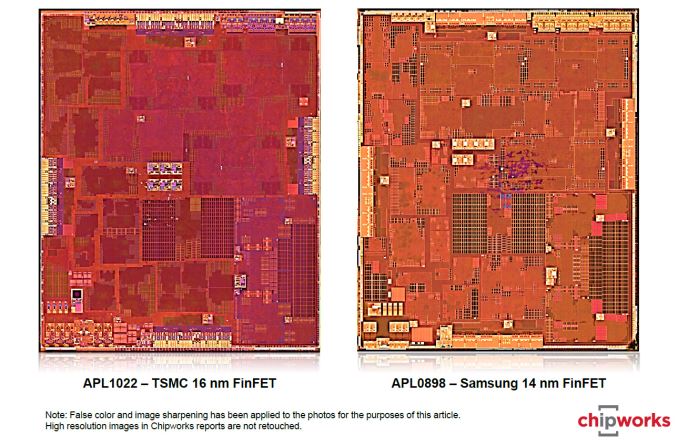
Apple A9 Die Shots (Image Courtesy Chipworks Teardown Report)
At this point then we don’t have anything new to add to the discussion – we don’t have enough data – though it is still a matter we are working on. Sometimes the best thing we can do is say is when we don’t have enough information, rather than extrapolating too much from too little information. I will note however that it’s ultimately in Apple’s best interests for the A9s to be as similar as possible, and there are steps they can take to ensure that, particularly in selecting which chips they will use.

Current A9 Chip Manufacturer Distribution (Image Courtesy Hiraku)
Meanwhile looking at the data collected by iOS developer Hiraku’s CPU Identifier project, it’s interesting to note that of the 250K+ phones sampled so far, the Samsung A9 is in 63% of those phones, giving us a Samsung-to-TSMC ratio of nearly 2-to-1. This survey should not be considered the final word in the ratio between the two A9s since it can change over time and an opt-in survey of this fashion has an inherent self-selection bias, but with so many results it should be a reasonably accurate summary of the current situation.
What remains to be seen – and likely never to be answered outside the walls of One Infinite Loop – is why Apple dual sourced in the first place. We can certainly speculate on reasons they would do this – yield issues at a fab, a desire to avoid putting all of their eggs in one basket and giving one fab too much power, or even just wanting to ramp up A9 production quickly by doubling the number of fabs working on it. What is apparent however is that with Apple selling 48M iPhones in Q3’15 (note that the majority of these were not 6ses), A9 is a uniquely good candidate for dual sourcing. Apple sells enough iPhones that their large pile of cash aside they can absorb the cost of dual sourcing by spreading out the costs over tens of millions of high-margin chips, and if yields/supply were a factor in this decision then that’s all the more reason to dual source. This in turn makes me wonder if we’ll see Apple continue this strategy given their enormous volume, or if this was a one-time event due to the early nature of FinFET, leading to them settling on a single fab for the iPhone 7 launch.
Die Size: Hitting the Sweet Spot
Finally, before jumping into our discussion of the A9’s CPU and GPU, let’s talk about A9’s die size in a historical context. Unlike the transition from A7 to A8, Apple doesn’t get the advantage of a substantial transistor density improvement going from A8 to A9. To use TSMC as an example here (since they produced A8), their 16nm FinFET process is advertised as having 2x the density as their 28nm process, however compared to that same 28nm process their 20nm process had a 1.9x density advantage. In other words, the transition from 20nm HKMG planar to 16nm FinFET does not bring with it the same kind of density improvements we’ve seen in the last few generations.
In fact the only other time Apple has not had the advantage of a density improvement is the transition from A4 to A5, which saw Apple’s die sizes transition from what remains their smallest die to their largest die, all in a single generation. For A9 then Apple has to work smarter, as they can’t add a large number of transistors relative to A8 without ballooning A9’s die size outside of Apple’s sweet spot (and harming chip yields at the same time).
| Apple SoC Evolution | |||
| Die Size | Transistors | Process | |
| A5 | 122m2 | <1B | 45nm |
| A6 | 97mm2 | <1B | 32nm |
| A7 | 102mm2 | >1B | 28nm |
| A8 | 89mm2 | ~2B | 20nm |
| A9 | 96mm2/104.5mm2 | >2B | 14nm/16nm |
Consequently the A9s that we’re getting are surprisingly conservative. The TSMC A9 is 104.5mm2, some 17% larger than the TSMC A8. Meanwhile the Samsung A9 is the smaller of the two at 96mm2. The TSMC A9 is now Apple’s second-largest non-X SoC, but just barely so; it’s only 2.5mm2 larger than the A7. Otherwise with an average die size of 100mm2, this puts the A9 at the upper-bounds of Apple’s sweet spot.
Yet despite the limited gains in transistor density versus A8, Apple has managed to “bulk up” their SoC design by quite a bit. We’ll go over this in greater detail on the following pages, but of particular note is that Apple is now implementing what we believe to be a 6 core PowerVR GPU design, and Apple has significantly increased both the L2 and L3 cache sizes. Coupled with this is the jump to LPDDR4 (requiring more complex memory controllers) and numerous smaller improvements we’ll likely never learn about. The number of CPU cores remains unchanged at 2 however.
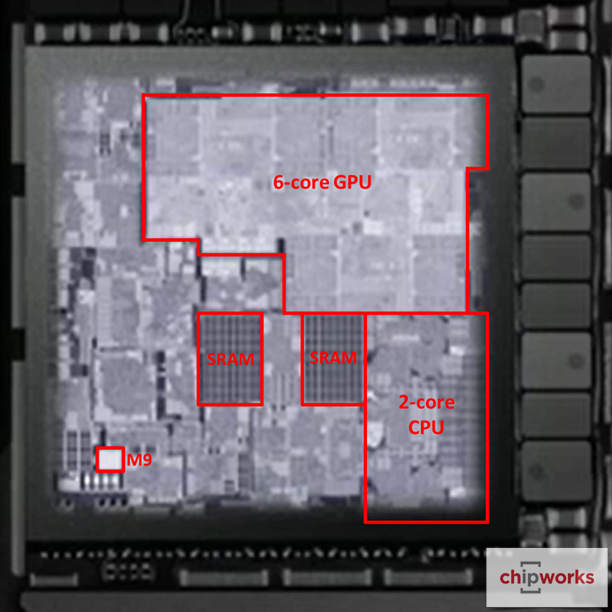
Chipworks' Initial Layout Analysis (Image Courtey Chipworks)
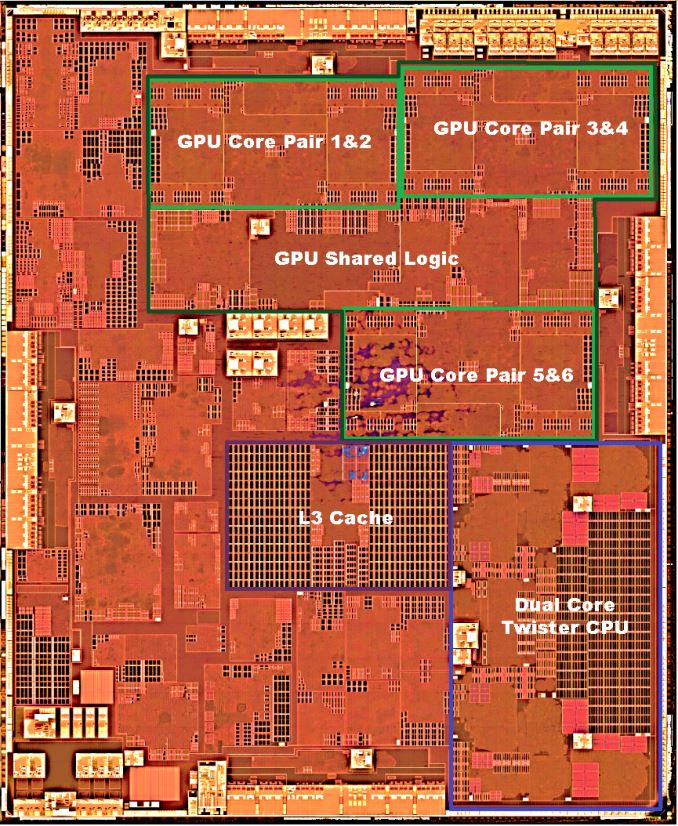
My Layout Analysis For A9 (Die Shot Courtesy Chipworks)
On a final note, now that we have die shots of both A9s from Chipworks, I must tip my hat towards Apple for releasing an accurate die shot of what we now know is the Samsung A9 in their iPhone 6s presentation. Up until now Apple has never released their own die shot of their SoCs, and in fact first-party die shots are becoming increasingly rare as a whole in the semiconductor industry. Consequently I had expected that Apple’s die shot was a fake, only to be far more impressed that it’s real. Furthermore despite the low resolution of the shot, Apple’s false color and contrast enhancements make it surprisingly clear where the CPU and GPU blocks are, and how many of each there are. This is a level of contrast that even the Chipworks shots can’t quite match this time around.


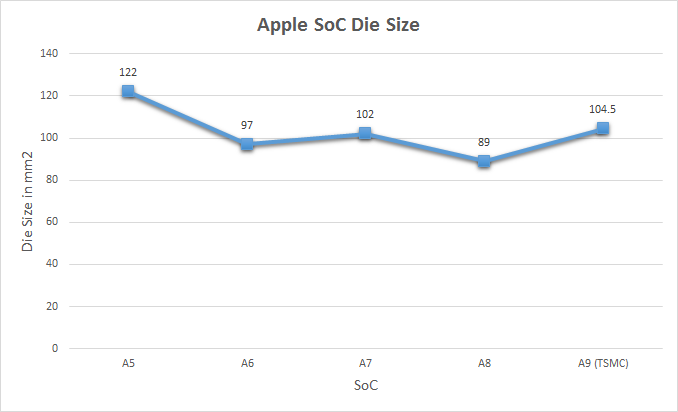








531 Comments
View All Comments
Der2 - Monday, November 2, 2015 - link
Its about time.zeeBomb - Monday, November 2, 2015 - link
Oh man...oh man it's finally here. I just wanted to say thank you for faithfuflly using all your findings to incorporate this review. It may have take a little longer than expected, but hey, this is my first anandtech review that I probably camped out for it to drop, lol...thanks again Joshua and Brandon!zeeBomb - Monday, November 2, 2015 - link
Ugh. I meant Ryan Smith...sorry! Waking up at 5 isn't the ideal way to go...Samus - Thursday, November 5, 2015 - link
That's what she said, Der bra.zeeBomb - Sunday, November 8, 2015 - link
Very valid point. Speaking of valid points... 500!trivor - Thursday, November 5, 2015 - link
Have to disagree with your statement that the high end Android phone space has stood still. With this round of phones the Android OEMs have all upped their game to approximate parity with the iPhones and in some cases exceed the performance and quality of images taken by an iPhone. In addition, on phones like the LG G4 the option of having manual control of your picture taking and supporting RAW/JPEG simultaneously is a huge advance for smartphones. Add to that, phase change focusing, laser rangefinder for close focus, generous internal storage (32 GB) and micro SD expansion (which works quite well on Lollipop - not sure about Marshmallow yet) you have a great camera phone. It also has OIS 2.0 (whatever that means) at a significantly lower cost than even the low end (16 GB) iPhone 6s @ $450-500 for the G4 versus $650 for the iPhone. While iOS seems to get apps updated a little quicker, look nicer from what I've heard and seem to be a little more feature rich. Conversely, the Material Design language has greatly improved the state of Android interfaces to give Android OEMs a much more stable OS - although the first builds of Lollipop were not ready for prime time. Also, let's not forget that Android dominates the low - middle range of Smartphones below $400 with near flagship specs, excellent cameras in phones like the Motorola Style (Pure Edition in the US), Motorola Play (is apparently the base model for the Droid Maxx 2 for Verizon, a number of the Asus Zenphones, the Moto G and E. Also, the new Nexus' (6P and 5X) are both competitive across the board with new cameras with 1.55 micron pixels that let in significantly more light than the 1.12 pixels in other cameras, are competitively priced (especially the 6P @ $499), and are overall very nice handsets. Finally, the customizability and wide variety of handsets at EVERY PRICE POINT make Android a compelling choice for many consumers.Fidelator - Friday, November 6, 2015 - link
I couldn't agree more, the Android space has not stayed still, if anything, most of the problems on that side were due to Qualcomm's lack of a good offering this year, still, the phones were further refines in other areas, saying this is overall the best camera phone given the only advantage it has over the competition is reduced motion blur is complete bull, the UI is far from the best given that auto on both the SGS6/Note 5 and the G4 is as effective yet those still offer great manual settings.The -barely over 720p- display on the 6S is inexcusable for 2015 and given the starting price of the 6S should not be passed as an acceptable not even as a good display.
Where Apple deserves credit is with the A9, it is miles ahead of anything the competition currently offers, they have made some fantastic design choices, it just is on the next level.
robertthekillertire - Monday, November 9, 2015 - link
I'm actually very happy with Apple's decision to stick with a lower-resolution screen. Which would you rather: a smartphone with an insanely high pixel count that your eyes probably can't appreciate anyway, or a smartphone with a lower PPI (but barely perceptibly so) that gets better battery life and has smoother UI and game performance because it's not trying to push an absurd number of pixels at any given moment? The tradeoff just doesn't seem worth it to me.MathieuLF - Tuesday, November 10, 2015 - link
But your eyes can tell the difference... When I had my iPhone 6+ and Nexus 6P side by side I can see it right away that the Nexus has more pixelsCantona7 - Tuesday, December 1, 2015 - link
But the difference is not large enough to justify heavier power consumption and greater graphics requirement. I agree that more pixels is certainly more pleasant to the eyes, but I'd rather greater battery life. If the Nexus 6P had a lower resolution screen, it would have a even greater battery life which would be awesome